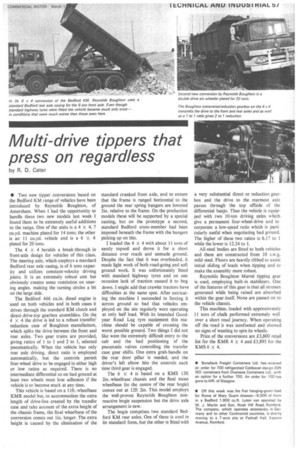Multi-drive tippers that press on regardless
Page 59

If you've noticed an error in this article please click here to report it so we can fix it.
by R. D. Cater • Two new tipper conversions based on the Bedford KM range of vehicles have been introduced by Reynolds Boughton, of Amersham. When I had the opportunity to handle these two new models last week I found them to be extremely useful additions to the range. One of the units is a 4 x 4, 7 cu.yd. machine plated for 14 tons; the other is an 11 cu.yd. vehicle and is a 6 x 4 plated for 20 tons.
The 4 X 4 heralds a break-through in front-axle design for vehicles of this class. The steering axle, which employs a standard Bedford rear axle casing, is of 6 tons capacity and utilizes constant-velocity driving joints. It is an extremely robust unit but obviously creates some restriction on steering angles. making the turning circles a bit on the large side.
The Bedford 466 cu.in. diesel engine is used on both vehicles and in both cases it drives through the standard KM clutch and direct-drive-top gearbox assemblies. On the 4 X 4 the drive is led to a robust transfer/ reduction case of Boughton manufacture, which splits the drive between the front and rear axles. Two gear trains are provided, giving ratios of 1 to 1 and 2 to 1, selected pneumatically. When the vehicle has only rear axle driving, direct ratio is employed automatically, but the controls permit four-wheel drive to be engaged in either high or low ratios as required. There is no intermediate differential so on bad ground at least two wheels must lose adhesion if the vehicle is to become stuck at any time.
This vehicle is based on a 1 lft.-wheelbase ICMR model but, to accommodate the extra length of drive-line created by the transfer case and take account of the extra height of the chassis frame, the final wheelbase of the conversion comes out lin. longer. The extra height is caused by the elimination of the standard cranked front axle, and to ensure that the frame is ranged horizontal to the ground the rear spring hangers are lowered Sin, relative to the frame. On the production models these will be supported by a special casting, but on the prototype a second, standard Bedford cross-member had been imposed beneath the frame with the hangers picking up on this.
I loaded the 4 X 4 with about 11 tons of sandy topsoil and drove it for a short distance over roads and unmade ground. Despite the fact that it was overloaded, it made light work of both road-going and soft ground work. It was unfortunately fitted with standard highway tyres and on one occasion lack of traction caused it to bog down. I might add that crawler tractors have difficulties at the same spot. After extricating the machine I succeeded in forcing it across ground so bad that vehicles employed on the site regularly were operating at only half load. With its intended Goodyear Road Lug tyre equipment this machine should be capable of crossing the worst possible ground. Two things I did not like were the extremely difficult entry to the cab and the bad positioning of the pneumatic valves controlling the transfer case gear shifts. One extra grab-handle on the rear door pillar is needed, and the driver's left elbow hits the controls each time third gear is engaged.
The 6 X 4 is based on a KMS 13ft 2in.-wheelbase chassis and the final mean wheelbase (to the centre of the rear bogie) comes out at 12ft 2in. This model employs the well-proven Reynolds Boughton nonreactive bogie suspension but the drive axle arrangement is new.
The bogie comprises two standard Bedford KM rear axles. One of these is used in its standard form, but the other is fitted with
a very substantial direct or reduction gearbox and the drive to the rearmost axle passes through the top offside of the differential banjo. Thus the vehicle is equip, ped with two 10-ton driving axles which. give a permanent four-wheel-drive and incorporate a low-speed ratio which is particularly useful when negotiating bad ground. The higher of these two ratios is 6.17 to 1 while the lower is 12.34 to 1.
All-steel bodies are fitted to both vehicles and these are constructed from 10 s.w.g. mild steel. Floors are heavily ribbed to assist initial sliding of loads when tipping and to make the assembly more robust.
Reynolds Boughton Marrel tipping gear is used, employing built-in stabilizers. One of the features of this gear is that all stresses generated while being raised are absorbed within the gear itself. None are passed on to the vehicle chassis.
This machine, loaded with approximately 11 tons of chalk performed extremely well over a short road journey. When operating off the road it was surefooted and showed no signs of wanting to spin its wheels.
Price of the conversions are £3,800 retail list for the KMR 4 X 4 and £3,895 for the KMS 6 X 4.








































































































































































